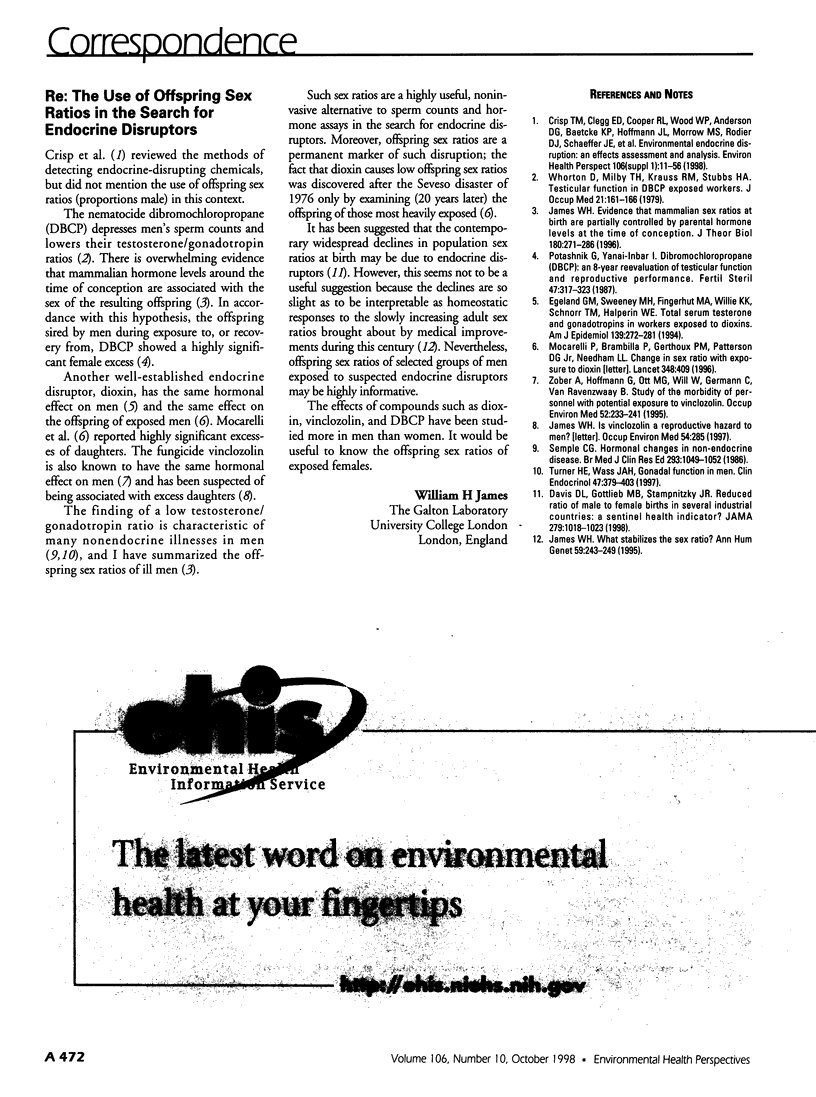Full text
PDFPage A472

Selected References
These references are in PubMed. This may not be the complete list of references from this article.
- Crisp T. M., Clegg E. D., Cooper R. L., Wood W. P., Anderson D. G., Baetcke K. P., Hoffmann J. L., Morrow M. S., Rodier D. J., Schaeffer J. E. Environmental endocrine disruption: an effects assessment and analysis. Environ Health Perspect. 1998 Feb;106 (Suppl 1):11–56. doi: 10.1289/ehp.98106s111. [DOI] [PMC free article] [PubMed] [Google Scholar]
- Davis D. L., Gottlieb M. B., Stampnitzky J. R. Reduced ratio of male to female births in several industrial countries: a sentinel health indicator? JAMA. 1998 Apr 1;279(13):1018–1023. doi: 10.1001/jama.279.13.1018. [DOI] [PubMed] [Google Scholar]
- Egeland G. M., Sweeney M. H., Fingerhut M. A., Wille K. K., Schnorr T. M., Halperin W. E. Total serum testosterone and gonadotropins in workers exposed to dioxin. Am J Epidemiol. 1994 Feb 1;139(3):272–281. doi: 10.1093/oxfordjournals.aje.a116994. [DOI] [PubMed] [Google Scholar]
- James W. H. Evidence that mammalian sex ratios at birth are partially controlled by parental hormone levels at the time of conception. J Theor Biol. 1996 Jun 21;180(4):271–286. doi: 10.1006/jtbi.1996.0102. [DOI] [PubMed] [Google Scholar]
- James W. H. Is vinclozolin a reproductive hazard to men? Occup Environ Med. 1997 Apr;54(4):285–285. doi: 10.1136/oem.54.4.285. [DOI] [PMC free article] [PubMed] [Google Scholar]
- James W. H. What stabilizes the sex ratio? Ann Hum Genet. 1995 Apr;59(Pt 2):243–249. doi: 10.1111/j.1469-1809.1995.tb00744.x. [DOI] [PubMed] [Google Scholar]
- Mocarelli P., Brambilla P., Gerthoux P. M., Patterson D. G., Jr, Needham L. L. Change in sex ratio with exposure to dioxin. Lancet. 1996 Aug 10;348(9024):409–409. doi: 10.1016/s0140-6736(05)65030-1. [DOI] [PubMed] [Google Scholar]
- Potashnik G., Yanai-Inbar I. Dibromochloropropane (DBCP): an 8-year reevaluation of testicular function and reproductive performance. Fertil Steril. 1987 Feb;47(2):317–323. doi: 10.1016/s0015-0282(16)50012-0. [DOI] [PubMed] [Google Scholar]
- Semple C. G. Hormonal changes in non-endocrine disease. Br Med J (Clin Res Ed) 1986 Oct 25;293(6554):1049–1052. doi: 10.1136/bmj.293.6554.1049. [DOI] [PMC free article] [PubMed] [Google Scholar]
- Turner H. E., Wass J. A. Gonadal function in men with chronic illness. Clin Endocrinol (Oxf) 1997 Oct;47(4):379–403. doi: 10.1046/j.1365-2265.1997.2611108.x. [DOI] [PubMed] [Google Scholar]
- Whorton D., Milby T. H., Krauss R. M., Stubbs H. A. Testicular function in DBCP exposed pesticide workers. J Occup Med. 1979 Mar;21(3):161–166. [PubMed] [Google Scholar]
- Zober A., Hoffmann G., Ott M. G., Will W., Germann C., van Ravenzwaay B. Study of morbidity of personnel with potential exposure to vinclozolin. Occup Environ Med. 1995 Apr;52(4):233–241. doi: 10.1136/oem.52.4.233. [DOI] [PMC free article] [PubMed] [Google Scholar]


